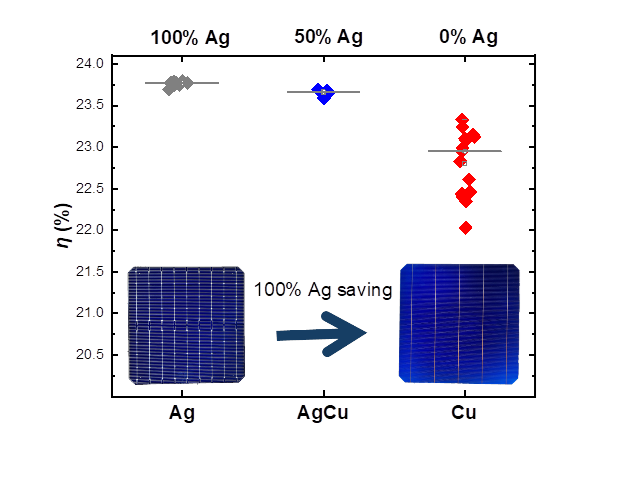High-Efficiency Silver-Free Silicon Heterojunction (SHJ) Solar Cells:
Revealing Cu paste based Metallization's Potential
Given the scarcity and volatile price of silver (Ag), traditionally used as a metal contact in solar cells, this research explored copper (Cu) and silver-coated copper (AgCu) pastes as alternative contacts for silicon heterojunction (SHJ) solar cells.
Ag is the industry-standard metal contact for solar cells. However, its scarcity and volatile price present a major challenge to upscaling photovoltaic (PV) production. To address this, our research explores Cu and AgCu pastes as alternative metallization materials for SHJ solar cells.
While Cu faces challenges such as oxidation and potential contamination of silicon, its high abundance and low cost make it a highly promising candidate for reducing dependence on Ag.
Key Findings
- Demonstrated high-efficiency SHJ solar cells metallized with Cu and AgCu pastes instead of the Ag paste.
- Using AgCu paste to achieve 50% Ag reduction resulted in 23.7% efficiency, with a minimal efficiency drop of only ~0.1%ab, thereby maintaining near-reference performance.
- Ag-free SHJ solar cells achieved over 23% efficiency using 100% Cu paste, with only ~0.4%ab loss compared to Ag-reference metallized solar cells.
Significance
This research demonstrates the viability of replacing or significantly reducing Ag in SHJ solar cells through the use of Cu and AgCu metallization, while maintaining high efficiency. It marks an important step toward:
- scalable, cost-effective PV production
- sustainable material usage
- achieving the industry target of 2 mg/W of Ag consumption per cell for next-generation solar technologies.
Further work is required to optimize Cu printing, particularly in reducing finger widths, standardizing processes, and improving stability and reliability.

Recognition
We are pleased to announce that our latest research, “Achieving High Efficiencies for Silver-Free SHJ Solar Cells”, has been published in the prestigious journal Progress in Photovoltaics (PiP).
The relevance of our findings has been further recognized by the solar community, with our results featured in PV Magazine, one of the leading platforms for global photovoltaic news. This milestone reflects our commitment to advancing sustainable and scalable PV technologies for the future of clean energy.
These results underline our commitment to advancing SHJ technology and demonstrate that Cu-based pastes can play a central role in enabling the future of sustainable, terawatt-scale solar energy.
Acknowledgements
We sincerely thank the SHJ Solar Cell and Module Group at the Institute of Energy Materials and Devices – Photovoltaics (IMD-3), Forschungszentrum Jülich, for their funding and support of this research. We also appreciate the valuable contributions from the Copprint team. This work received funding from European Union through the Horizon project EMPOWER. Views and opinions expressed are however those of the authors only and do not necessarily reflect those of the European Union or the granting authority. Neither the European Union nor the granting authority can be held responsible for them.
